Woy Woy
First organ: B. 1971 J.P. Eagles. 1m., 2 rks. 8.4.4.2. ext.: autobass, el.mag.
Restored in parish hall (former church building) 2008 Darrell Pitchford
Second organ: 2006 bought redundant organ from Third Church of Christ Scientist, Mosman
B. 1955 Hill, Norman & Beard (o/n N307). Enl. 1972 Pitchford & Garside
2m., 14 sp.st., 8c., el.pn. Gt: 8.8.8.4.4.2. Sw: 8.8.4.II.8. Ped: 16.8.4.
Rebuilt 2007-8 for present location by Darrell Pitchford and Australian Pipe Organs, Melbourne
2m., 22 sp.st., 6c., el.pn. Gt: 8.8.8.4.4.2.III.8 Sw: 8.8.8.4.2.8.8. Ped: 16.8.8.4.4.16.8.
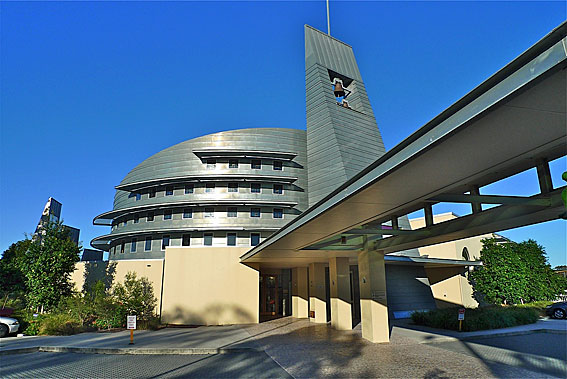
Photo: Trevor Bunning (June 2011)
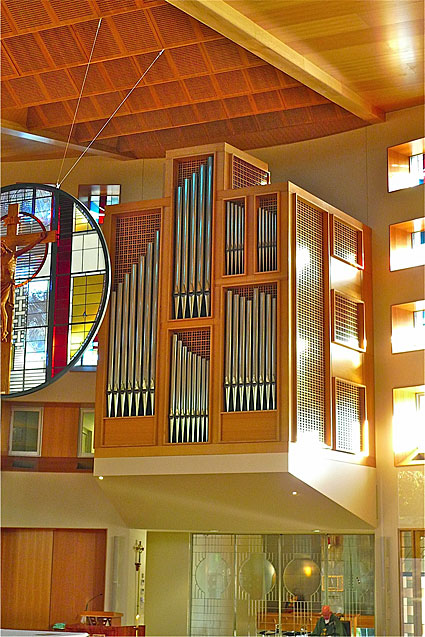
Photo: Trevor Bunning (June 2011)
THE NEW ORGAN AT THE CHURCH OF ST-JOHN-THE-BAPTIST, WOY WOY
STORY BY DARRELL PITCHFORD
PHOTOS BY DEAN YATES
Saturday 29 March 2008 saw the dedication and opening recital of a new pipe organ for St John the Baptist Catholic Church at Woy Woy on the Central Coast of New South Wales. His Eminence Cardinal Edward Cassidy dedicated the organ and in his address spoke of the need for music within the church, especially pipe organs.
The project’s consultant, Sydney organist Peter Kneeshaw played the opening recital to a full church and as always was so generous with his time and talents. Peter played music that most people on the Central Coast heard for the first time. The recital was followed by the 5.00 pm Vigil Mass. Peter played for the mass, demonstrating to the packed congregation and choir the versatility of their new acquisition. The parish and I owe much to Peter Kneeshaw.
Pipe organs of the Central Coast. Until now, a book about the pipe organs on the Central Coast (i.e., between Brooklyn and Doyalson) would consist of two pages: Geoff Bock’s house organ, Doug Whitfield’s theatre organ and an Eagles two rank cabinet organ in St John the Baptist Church, Woy Woy comprised the total.
Woy Woy parish purchased the Eagles organ in 1972. As the resident organ builder on the Central Coast we visited this organ for a number of years. Mr Patrick Donnellan, a parishioner of Woy Woy parish, a local lawyer and regular participant in all things musical was determined that when a new church was built,a pipe organ would be included in the project.
Many years of planning for the new church had taken place. Three Catholic churches on the Woy Woy peninsula would be amalgamated and a new church built across the road from the existing one. A new organ was prohibitive due to the excessive cost, therefore, a second-hand organ was the only option. The brief was simple: it would need to be able to lead a congregation of 450+, it must have a detached console and be organist/pianist friendly.
The search. We decided to make this easier by enlisting Peter Kneeshaw as the consultant for the project. With his expertise and connections, it shouldn’t take long. Our search started in Australia in 2004 but there was nothing suitable. There are literally hundreds of overseas organs for sale and it was thought that the Internet would make the search easy. All the known sites proved fruitless. Many, many hours of searching, constant communications between Peter, Patrick and myself left us thinking that the quest was doomed. We tried everything, even “googling” secondhand organs for sale in different languages. This strategy did unearth more organs, however, none was suitable. They were either too big, too small, too expensive, too old or had mechanical actions that could not be converted to electric.
After many months, finally a breakthrough. A mechanical action organ in Germany that could easily be converted to electric as it already had electric couplers was found. At the time,Peter Kneeshaw was on a European tour with St Aloysius’ College Choir and would be within a few hours travel from where the organ was located. The church engaged Peter to visit and report on the organ. Peter spent many hours talking to the organist,members of the church, the company which made the organ and even arranged for a demonstrationCD to be sent via computer back to us in Australia. Peter also inspected a similar organ in another city that the German organ builders had recently renovated and revoiced. He recommended that we make an offer but unknown to us, the church had already received a bid from another church. Negotiations ceased.
Coincidence? My father, Ted Pitchford, arrived in Australia from England in August 1955. He was the New South Wales representative for Hill Norman & Beard. His diaries show that he visited the new Hill Norman & Beard organ installed in1955 in the Christian Science Church at Mosman. Ted, Stuart Garside and myself had looked after the organ for 50 years. One Friday night the Session Clerk rang to inform us that the church was closing and would we know of anyone who would be interested in the organ. It was crammed into an attic at the front of the church and spoke through small vents and the action was accessed through manholes cut in the floor below, in the readers’ room, in the hallway and even one in the toilet. Donnellan and I met at the church which was about the same size as the proposed church for Woy Woy. Tonally the HN&B was designed as a “Hymn Machine” with the following original specification.
| Great Open Diapason Dulciana Principal Fifteenth Swell Rohr Flute Salicional Flute Ouverte Trumpet Tremulant Pedal Bourdon Bass Flute Octave Flute Couplers Sw/Gt Sw Oct Sw Sub Sw/Ped Gt/Ped |
8 8 4 2 8 8 4 8 16 8 4 |
(ext) (ext) |
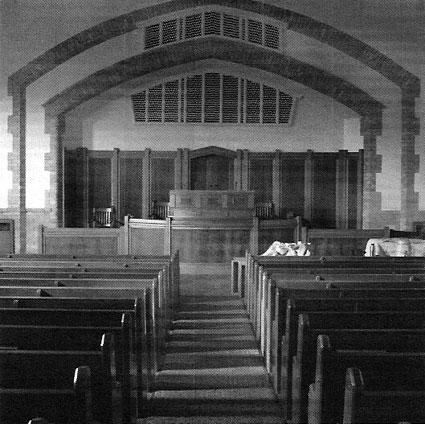
Christian Science Church, Mosman, original home of the organ
(Sydney Organ Journal, Winter 2008)
The action was HN&B Pitman soundboards. The “tuners” book shows that in 50 years, the bottom boards of the chests had never been removed to fix any problems. In the 70s Ted and Stuart added a Flute 8 with a 4’ extension to the Great and a 2 rk Mixture (12th, 15th) to the Swell. A new BOB blower was also installed at that time.
The plans for the new church were, by now, being finalised. We knew that the HN&B would be a reliable instrument and surely it would sound better once it was freed from its attic. Time was running out to find an organ for Woy Woy so (with a little doubt), we recommended that the church purchase the organ. It was dismantled in December 2005. We couldn’t waste valuable dollars on storage, so it was stored in our house at Wamberal.
The rebuild. There was much to do to make the organ serviceable in the new church. A building frame was manufactured,three bellows releathered, a new bellows made for the Pedal division, all pneumatic soundboard motors releathered (488using kangaroo skin), new wind trunks made, new guillotine wind controls made. All magnets were replaced, valves releathered,swell engine restored and a coat of paint applied (to cover the mistakes).
The organ in its original location did not have a case. We needed to produce a design that would be acceptable in a 21st century building. Mr Randall Lindstrom (the designer of the new church), came up with a plan that was modern yet not overbearing and which works well. The old console was completely rebuilt,attached to a moveable platform and painted a colour consistent with the interior of the church. The organ budget would not stretch to make wholesale changes to the pipe work. The Trumpet was removed from the swell and placed on it’s own chest so that it could be played on all divisions. A 16’ extension was added to give the pedal more variety.
The Trumpet was replaced by an Oboe 8 on the Swell chest. Australian Pipe Organs P/L , in Melbourne just happened to have a secondhand HN&B Oboe from around the same period as our organ. Coincidence? A Piccolo 2 was also added to complete the Flutes on the swell. Another addition on the swell was a Celeste 8 from tenor C. This stop was the organ builders’ indulgence.
The original 2-rk Mixture was removed from the Swell and remade into a 3 rank mixture (15,19,22) for the Great. As we were having new front pipes it seemed prudent to make them“speakers”. Seventeen of the front pipes and a further 25 pipes inside the organ make up the new Pedal Principal 8 and Choral Bass4made by APO. The organ case front has 39 pipes made from electrolytic zinc. New electrics were installed and to make the organ user friendly, a Melodic Bass and transposer were included. The melodic bass plays all pedal stops drawn from the lowest note played in a chord on the great manual.
8 General pistons, 3 pistons on great and swell, 3 pistons on the pedal, Full Organ piston and General Cancel piston complete the keyboards. Included are 12 levels of memory. The final specification is:
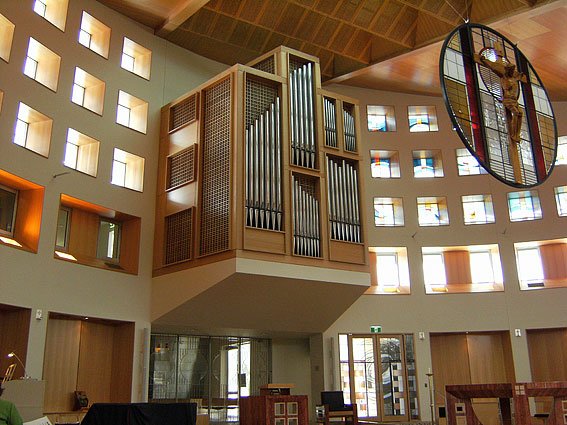
| Great Open Diapason Dulciana Gedackt Principal Nason Flute Fifteenth Mixture Trumpet Swell Salicional Voix Celeste Rohr Flute Flute Piccolo Trumpet Oboe Tremulant Pedal Bourdon Principal Bass Flute Choral Bass Octave Flute Trombone Trumpet Couplers Sw Sub Sw Unison off Sw Oct Sw/Gt Sw/Ped Gt/Ped Gt & Ped Pistons combined Melodic Bass. |
8 8 8 4 4 2 III 8 8 8 8 4 2 8 8 16 8 8 4 4 16 8 |
A A B B C D C D C B B * * * |
* all play through to the Great via Sw/Gt
3 Swell thumb pistons
3 Great thumb pistons
3 Pedal toe pistons
8 General thumb pistons
General Cancel
Set
Full Organ (thumb piston)
Swell to Pedal reversible thumb piston
Great to Pedal reversible thumb piston
Swell to Great reversible thumb piston
12 levels of memory
Transposer (-5 to +5)
The organ was at last free of the attic, and the tonal improvement was incredible. Happily, the project has been declared a success by all who have heard it. After 28 years living on the Central Coast,we now have a pipe organ that will serve the Woy Woy parish well.
The people involved in the project deserve recognition. The Parish Priest, Fr John Hill for his drive and energy throughout the building of the church. The music and finance committee for their support (and not asking too many questions). Randall Lindstrom for his incredible design and vision of the church. Robert Heatley and Australian Pipe Organs P/L for the manufacture of pipes, chests and tonal finishing. My wife Cathy and family. Dean Yates, a great help and workmate throughout the project. Peter Kneeshaw for everything. Patrick Donnellan; his determination and support is an inspiration to all.
At 6 pm after a great day on 29th March 2008 the organ was switched off. Everything went to plan. We now have time to reflect and hope that the notional book “Organs of the Central Coast” will in the future, increase in size.
The Organ Consultant’s View. Throughout the planning stages of the new Catholic Church in Woy Woy, the building committee, chaired by Patrick Donnellan with full support from the Parish Priest, Father John Hill, remained committed to their decision to install a pipe organ even though they had a very restricted budget. Funds were insufficient for a new instrument or to carry out extensive restoration of an old redundant instrument.
Initially my brief as organ consultant was to find a fairly new, cheap, redundant mechanical action organ similar to the secondhand organ installed recently in the chapel at St Aloysius’ College,Milson’s Point. After looking within Australia I investigated and inspected some small two manual instruments in the United States. These were rejected as I felt that they all had a sound that was too brittle and that they had very few foundation stops.
As the experienced architect, Randall Lindstrom, progressed with drawings for the new church it was obvious that the choir, cantors and musicians were to be located at floor level and that the organ was to be elevated several metres above on a concretes lab behind the altar. This location was fully supported by the acoustic consultant and was accepted. As they intended the organist to be near the other musicians the only practical solution was to have an elevated organ with electric action and a console at floor level close to the instrument.
After a further search for redundant organs with electric action I recommended an instrument I inspected in a German church that was about to be demolished. I made detailed preparations for bringing it to Australia and installing it at Woy Woy. Unfortunately the trustees of the German church decided not to accept the offer from Woy Woy Parish or to negotiate further.
When I first saw and heard the 1955 Hill Norman &Beard organ in the Christian Science Church in Mosman I was not very impressed with the sound. The organ did have a few ranks that had a great deal of potential but not all the ranks blended. It had an unsuccessful two rank Mixture on the Swell with only 8’and 4’ flutes to support it and the Pedal Division was very ineffective even when coupled. I admit that the sound was severely contained within a chamber that had a very small opening for egress.
A decision was made quickly to purchase the instrument as the Mosman church had already been sold. At this point I leave it to the organ builder, Darrell Pitchford, to tell you his story about the work on the instrument, its history and additions, including the new case.
The Parish Priest, Building Committee, architect, Parish musicians, Parish organist and I are all very impressed with the final musical result and believe that the enlarged instrument is right for the “room” and its role. The added pipework is in sympathy with the tonal scheme and blends with the existing ranks. The overall sound is enhanced by the location of the instrument and the acoustic of the building, which has no carpet.
It was a pleasure to be involved in this project. I enjoyed working with such a team of positive, inspired people at the church and particularly wish to place on record my congratulations to Darrell Pitchford and staff on the successful outcome.
Peter Kneeshaw
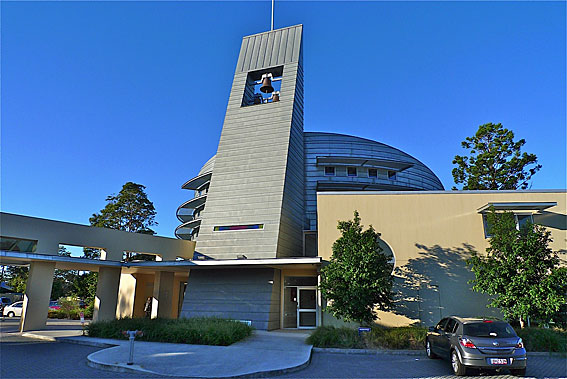
Photo: Trevor Bunning (June 2011)
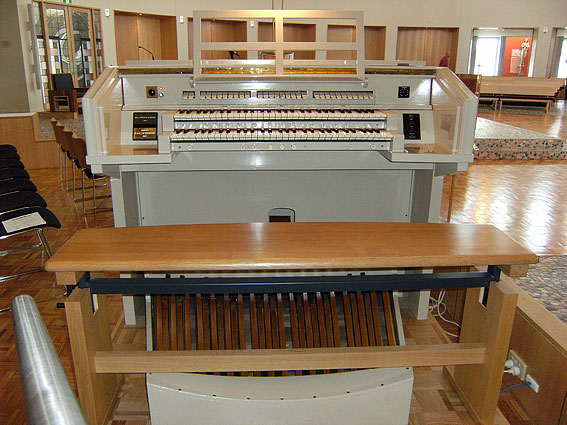
|
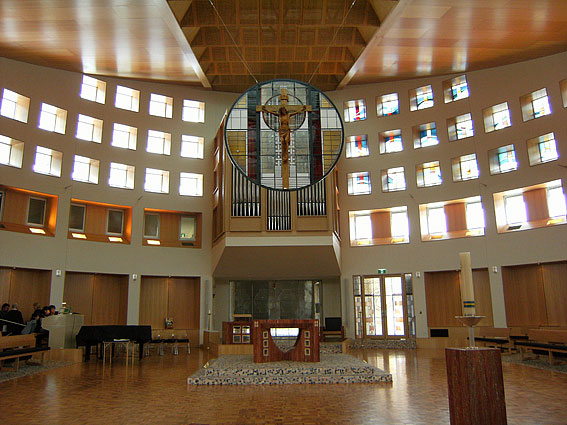
|
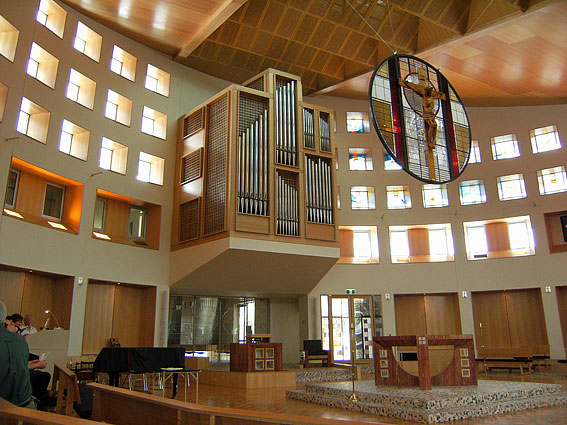
|

|
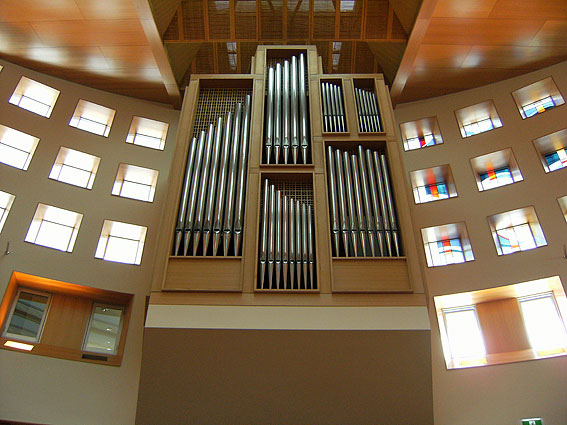
|
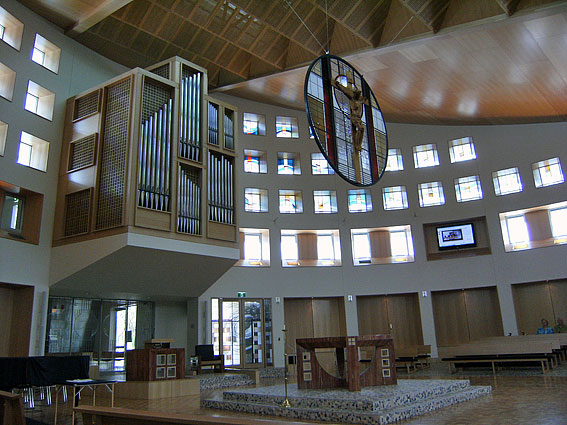
|
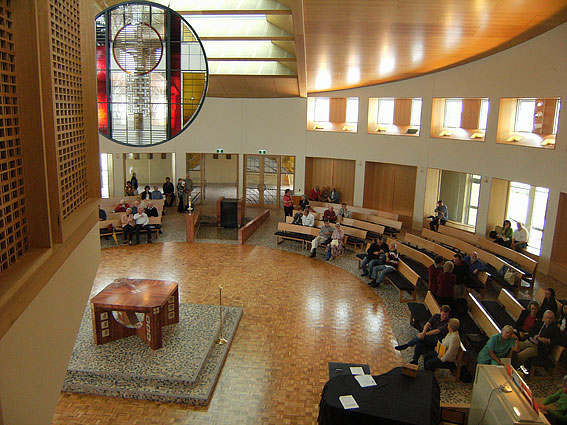
|

|
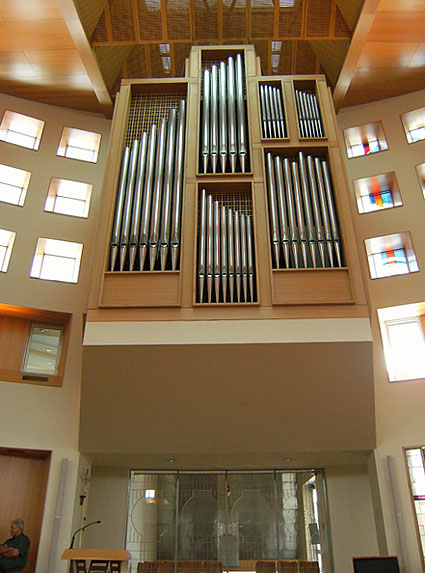
|
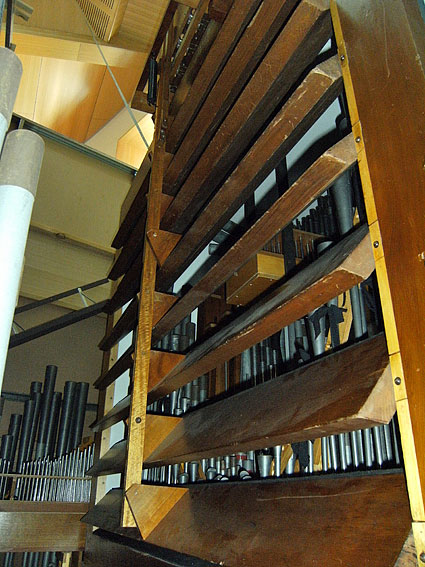
|
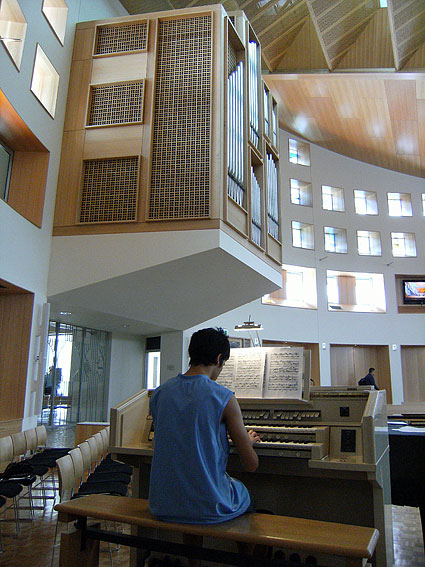
|
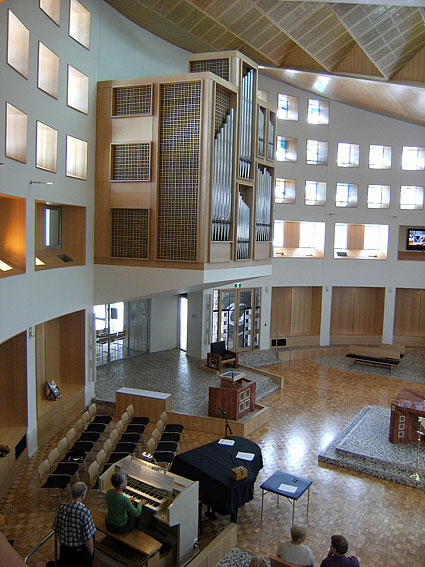
|
Catholic Church Parish Hall
(former church building)
Woy Woy
B. 1971 J.P. Eagles. 1m., 2 rks. 8.4.4.2. ext.: autobass, el.mag.
rem. to parish hall 2008 Darrell Pitchford
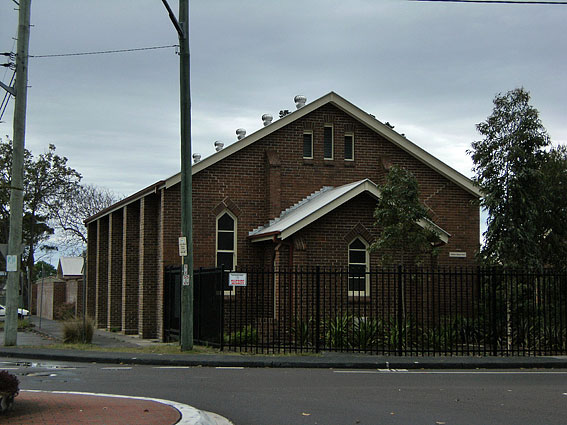
Parish Hall (former Church)
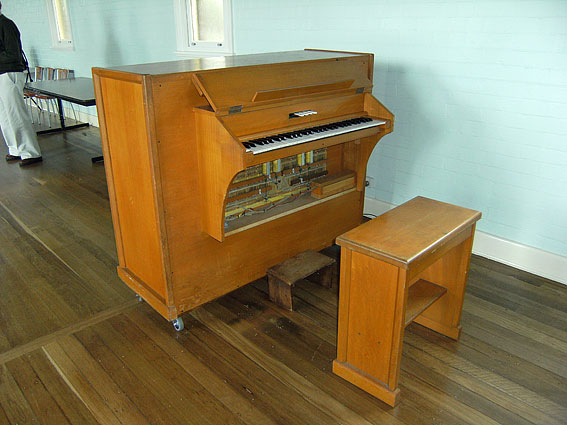
| Manual Flute Flute Octave Fifteenth Autobass |
8 4 4 2 |
A A B B |
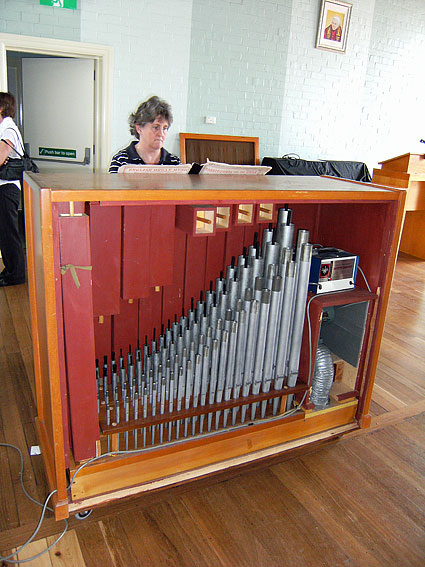
Photos: MQ (October 2008)